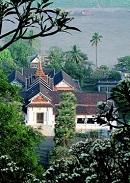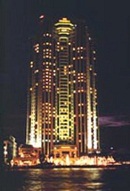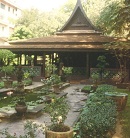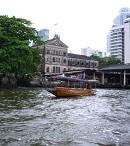Thailand Architectural Diversityby Harold Stephens,
Travel Correspondent for Thai Airways International
Any one who comes to Thailand for the first time is certain to be amazed, and perhaps even awed, by the diversity of architecture they see everywhere. It appears to be a hodgepodge of everything, Roman classic, Victorian, modern deco and a mixture of Thai, Burmese and Khumer. A short cruise on the Chao Phraya River and you can see them all, some side by side.
The varied architecture along the river is indeed dazzling: palaces and royal residences with multilevel roofs, Chinese mansions with Victorian facades and carriage porches, high-rise hotels and condominiums of glass and concrete, Thai temples of upturned eaves and Chinese temples with stone lions guarding the entrances, onion domed Muslim mosques and Gothic and Roman churches, 19th century embassies and custom houses from a forgotten colonial period, crenelled forts, tin-roof godowns, spacious bungalows of the rich with manicured lawns standing side-by-side with clapboard houses on stilts over the water of the poor, gain silos and storage tanks, apartments on river boats that house the families of working river people, and then there are the traditional Thai houses with high sloping roofs, and the array of confusing temples, wats and stupas,
Why the bewildering array of architecture?
After the Chakri kings reestablished Bangkok as the new capital a little more than two hundred years ago, they attempted to recreate as much as possible the glory of Ayutthaya. Rama I brought down river typical Ayutthayan structures that had been featured in the palace and Buddhist temples, and including all the chedis, prangs, and viharns, which I will explain later.
Rama III embellished upon the temples and places during his reign and added Chinese overtones. Then a few years later, King Mongkut, Rama V, embraced Western neoclassical styles then popular in Europe.
King Rama V, one of the most beloved of all Thai kings, was the first Thai king to travel abroad, and as a result he was determined to modernize Thailand. He launched a programme to introduce western architectural designs to Thailand. He constructed European traditional tree-lined boulevards patterned after those he saw in Paris and Rome. He had his engineers lay out parks and had them build brigades over the klongs, or canals. His most advance project was when he built a new palace and throne hall, both in western style.
Aside from temples and shrines, with their up-turned eves and dazzling gold trim, there are the traditional Thai houses. Within the city, they become lost from view, hidden behind high walls and dwarfed by highrises, but along the river they stand out in all their unobstructed beauty.
The traditional Thai houses seen along the river and elsewhere are mostly private residences, the kind that once graced the entire countryside. They eventually gave way to western styles and tastes after World War II, when cheaper building material was more readily available. In relatively recent years, however, there has there been a revival of interest in these old classical house. It began with Jim Thompson, the Thai Silk King who vanished without a trace in the Cameron Hills in the Malaysia highlands in the late 1960s. Jim Thompson erected his now famous Jim Thompson House on a klong in Bangkok from teak houses he bought in the north and shipped down river to their new location. A few years later, he built another similar house for his dear friend Connie Mangskau which also became a showpiece in Bangkok for foreign dignitaries to Hollywood stars. The story of the disappearance of Jim Thompson, along with more about Connie Mangskau (she was with him when he disappeared), I will save for later.
These elegant houses with curved eaves, steep roofs, and teak-paneled walls were, above all, practical. They were built on pillars to keep them dry in all weather and artfully designed to catch any breeze. They were also prefabricated, that is, not nailed but joined only with wooden pegs, thus making them easy to dismantle and move to new locations.
What many visitors find confusing are the many religious Buddhist shrines and temples they see scattered around the city and countryside. I will attempt an explanation without becoming too technical, and hopefully not boring. It is a fascinating study.
Foremost to remember, Thailand is a land of temples. She has over 30,000 Buddhist temples which, fortunately, share common types of structures. At the latest count, Bangkok has over 400, with many dozens currently under construction.
A name we see most is wat. An entire religious complex is known as a wat, as opposed to temple, a singular place dedicated to the worship of a god. Wats serve as religious institutions, schools, community meeting halls, hospitals, entertainment venues, and homes for the aged and abandoned. Some even serve as drug rehabilitation centers. And when stray dogs are rounded up, they are brought and deposited at a wat. Monks take on the responsibility of feed stray animals, moneys included.
Wats are named after the kings who constructed them, or after Thai royalty who either constructed or restored them. Others might be named for the Buddha images they house.
Then we come to chedi and stupa.
Chedi is the Thai name for the Indian stupa. In days of old, these dome-shaped monuments that we see at every bend of the river held such relics of the Buddha as pieces of bone or hair. Later replicas were erected over the remains of kings or important royalty, while today anyone with money to pay can have a chedi erected for a place to hold his or her ashes.
A chedi consists of a three-tiered base with a bulbous stupa on top. Above this is a multitiered and highly stylized umbrella ringed with colourful moldings.
A chedi is not to be confused with a prang. Wat Arun, that glorious temple we see across the river from Bangkok, and the most photographed structure in Thailand, is an example of a prang. It’s design originates from Cambodian temples.
Before Buddhism reached Siam, Hinduism prevailed and left its influence, mainly on the architecture. The Khumer kings of Cambodia, who in early years were Hindu, spread their empire throughout all of Southeast Asia and into northern Thailand. While many of these massive stone-carved temples are in ruin today, others still stand and have become devotion centres for many Thais.
For those who want to peruse the arts and architecture of Thailand, two excellent books on the subject can be found in most book stores and hotel kiosks. They are Thai Style by William Warren and The Arts of Thailand by Steve Van Beek. Both books were photographed by Luca Invernizzi Tettoni.
Harold Stephens
Bangkok
E-mail: ROH Weekly Travel (hstephens_1@yahoo.com)
Note: The article is the personal view of the writer and does not necessarily reflect the view of Thai Airways International Public Company Limited. | 
Old Siam, the way it once was | | 
River view the new BANGKOK | | 
Modern, Peninsula Hotel | | 
Kukrut house, example of past residences | | 
New Road, always conjested | | 
The Old Custom House dating back to Conrad’s time
|
|





